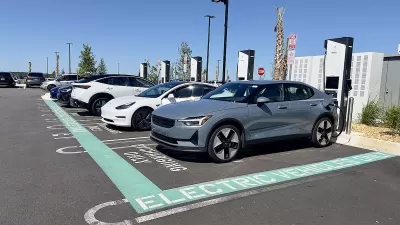As more electric cars and trucks hit U.S. roads, large charging stations could require as much power as a small town.

The debate over how the electric grid will handle a rising number of electric vehicles continues, as Tom Randall outlines the potential energy needs of an electric charging station for Bloomberg Green.
The problem isn’t the amount of electricity required, Randall notes. “The real challenge is how quickly high-speed chargers will need to deliver electricity at a single place and time.” According to Dave Mulaney of the RMI research institute, “Utilities need to be starting half a decade ahead of the trucks in order to not be bottlenecking the transition to electric trucks.”
Randall cites a study by utility company National Grid Plc. “Researchers found that by 2030, electrifying a typical highway gas station will require as much power as a professional sports stadium—and that’s mostly just for electrified passenger vehicles. As more electric trucks hit the road, the projected power needs for a big truck stop by 2035 will equal that of a small town.”
Brian Wilkie, director of transport electrification at National Grid, says that “Building connected electricity highways will be a competitive advantage for states that move the fastest, and every utility should be conducting similar studies to evaluate future demand.”
FULL STORY: Electric Truck Stops Will Need as Much Power as a Small Town

Maui's Vacation Rental Debate Turns Ugly
Verbal attacks, misinformation campaigns and fistfights plague a high-stakes debate to convert thousands of vacation rentals into long-term housing.

Planetizen Federal Action Tracker
A weekly monitor of how Trump’s orders and actions are impacting planners and planning in America.

Chicago’s Ghost Rails
Just beneath the surface of the modern city lie the remnants of its expansive early 20th-century streetcar system.

Bend, Oregon Zoning Reforms Prioritize Small-Scale Housing
The city altered its zoning code to allow multi-family housing and eliminated parking mandates citywide.

Amtrak Cutting Jobs, Funding to High-Speed Rail
The agency plans to cut 10 percent of its workforce and has confirmed it will not fund new high-speed rail projects.

LA Denies Basic Services to Unhoused Residents
The city has repeatedly failed to respond to requests for trash pickup at encampment sites, and eliminated a program that provided mobile showers and toilets.
Urban Design for Planners 1: Software Tools
This six-course series explores essential urban design concepts using open source software and equips planners with the tools they need to participate fully in the urban design process.
Planning for Universal Design
Learn the tools for implementing Universal Design in planning regulations.
planning NEXT
Appalachian Highlands Housing Partners
Mpact (founded as Rail~Volution)
City of Camden Redevelopment Agency
City of Astoria
City of Portland
City of Laramie





























